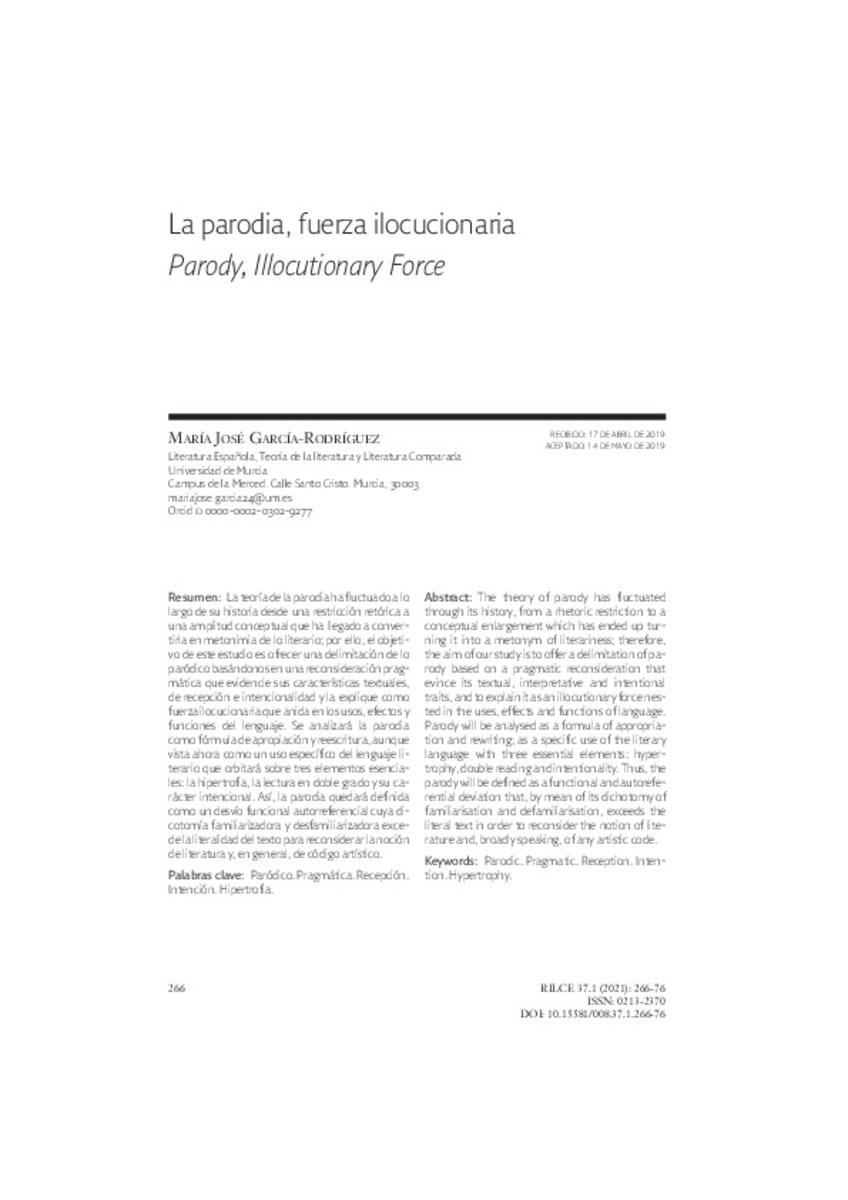Full metadata record
| DC Field | Value | Language |
|---|---|---|
| dc.creator | García-Rodríguez, M. J. (María José) | - |
| dc.date.accessioned | 2020-12-21 | - |
| dc.date.accessioned | 2021-08-30T07:28:11Z | - |
| dc.date.available | 2021-08-30T07:28:11Z | - |
| dc.date.issued | 2020 | - |
| dc.identifier.citation | García-Rodríguez, M.J. (María José). "La parodia, fuerza ilocucionaria". Rilce. Revista de Filología Hispánica. 37 (1), 2020, 266 - 76 | es |
| dc.identifier.issn | 0213-2370 | - |
| dc.identifier.uri | https://hdl.handle.net/10171/61840 | - |
| dc.description.abstract | The theory of parody has fluctuated through its history, from a rhetoric restriction to a conceptual enlargement which has ended up turning it into a metonym of literariness; therefore, the aim of our study is to offer a delimitation of parody based on a pragmatic reconsideration that evince its textual, interpretative and intentional traits, and to explain it as an illocutionary force nested in the uses, effects and functions of language. Parody will be analysed as a formula of appropriation and rewriting; as a specific use of the literary language with three essential elements: hypertrophy, double reading and intentionality. Thus, the parody will be defined as a functional and autoreferential deviation that, by mean of its dichotomy of familiarisation and defamiliarisation, exceeds the literal text in order to reconsider the notion of literature and, broadly speaking, of any artistic code. | en_US |
| dc.description.abstract | La teoría de la parodia ha fluctuado a lo largo de su historia desde una restricción retórica a una amplitud conceptual que ha llegado a convertirla en metonimia de lo literario; por ello, el objetivo de este estudio es ofrecer una delimitación de lo paródico basándonos en una reconsideración pragmática que evidencie sus características textuales, de recepción e intencionalidad y la explique como fuerza ilocucionaria que anida en los usos, efectos y funciones del lenguaje. Se analizará la parodia como fórmula de apropiación y reescritura, aunque vista ahora como un uso específico del lenguaje literario que orbitará sobre tres elementos esenciales: la hipertrofia, la lectura en doble grado y su carácter intencional. Así, la parodia quedará definida como un desvío funcional autorreferencial cuya dicotomía familiarizadora y desfamiliarizadora excede la literalidad del texto para reconsiderar la noción de literatura y, en general, de código artístico. | es_ES |
| dc.language.iso | spa | - |
| dc.publisher | Servicio de Publicaciones de la Universidad de Navarra | es_ES |
| dc.rights | info:eu-repo/semantics/openAccess | es_ES |
| dc.subject | Paródico | - |
| dc.subject | Pragmática | - |
| dc.subject | Recepción | - |
| dc.subject | Intención | - |
| dc.subject | Hipertrofia | - |
| dc.title | La parodia, fuerza ilocucionaria | es_ES |
| dc.title.alternative | Parody, Illocutionary Force | en_US |
| dc.type | info:eu-repo/semantics/article | es_ES |
| dc.identifier.doi | 10.15581/008.37.1.266-76 | - |
| dadun.citation.endingPage | 76 | - |
| dadun.citation.number | 1 | - |
| dadun.citation.publicationName | Rilce. Revista de Filología Hispánica | - |
| dadun.citation.startingPage | 266 | - |
| dadun.citation.volume | 37 | - |
Files in This Item:
Statistics and impact
Items in Dadun are protected by copyright, with all rights reserved, unless otherwise indicated.






